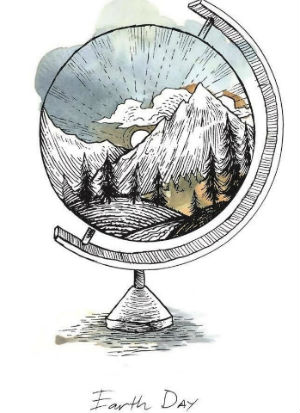Many of us will be spending Earth Day at home for the first time in years. April 22, 2020, marks the 50th anniversary of the event, the brainchild of Gaylord Nelson, U.S. senator from Wisconsin, who was moved to start a "national teach-in on the environment" after he witnessed the devastation of a 1969 oil spill in Santa Barbara, Calif.
 Thanks to Earth Almanac: Nature's Calendar for Year-Round Discovery by Ken Keffer, illustrated by Jeremy Collins (Skipstone Press, $24.95), readers young and old can celebrate the great outdoors all year long. Keffer, a naturalist and educator, begins with the winter solstice, December 21, noting, "the darkest days of winter are now officially in the past." He then explains why it's the shortest day (in the Northern Hemisphere) and organizes the book around the seasons. Jeremy Collins's pen-and-ink illustrations with watercolor wash simulate a field guide, as he sketches a pair of horned owls in the act of squatting in another bird's nest, a spotted skunk just after it's unleashed its spray (Keffer explains it takes 10 days for a skunk to "restock the spray supplies" and suggests a shampoo for pets that's more effective than tomato baths), even a dinosaur track!
Thanks to Earth Almanac: Nature's Calendar for Year-Round Discovery by Ken Keffer, illustrated by Jeremy Collins (Skipstone Press, $24.95), readers young and old can celebrate the great outdoors all year long. Keffer, a naturalist and educator, begins with the winter solstice, December 21, noting, "the darkest days of winter are now officially in the past." He then explains why it's the shortest day (in the Northern Hemisphere) and organizes the book around the seasons. Jeremy Collins's pen-and-ink illustrations with watercolor wash simulate a field guide, as he sketches a pair of horned owls in the act of squatting in another bird's nest, a spotted skunk just after it's unleashed its spray (Keffer explains it takes 10 days for a skunk to "restock the spray supplies" and suggests a shampoo for pets that's more effective than tomato baths), even a dinosaur track!
Readers may read the day's entry, dip in and out, or power straight through, searching for family activities, such as putting out a feeder or fruit to attract butterflies and using a white sheet to enhance moth-watching. Keffer covers a wide range of the sciences, from botany to astronomy, dots the pages with humor ("Were there ever any flamingos... in Flamingo, Florida?"--and goes on to give the sobering answer), as well as surprises: Did you know that beluga whales molt (as do orcas and bowhead whales)? A handy index highlights entries that tie in with "Citizen Science Opportunities," as well as specific animals, flora and fauna. --Jennifer M. Brown, senior editor, Shelf Awareness


